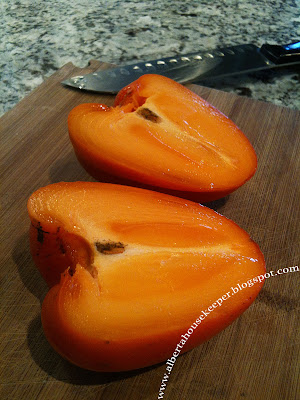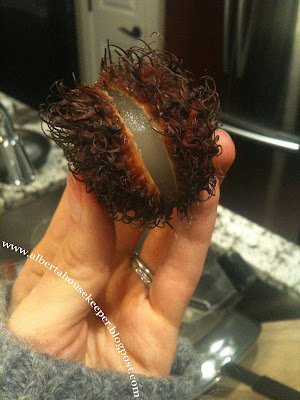Under the continuous influence of the defeatist effects of my months-long quest for the truth, I did what in the past proved uplifting and, at least in the short term, healing. Grocery shopping in the Okanagan, ever since the original settlement in mid October, has always been more than just a chore. In fact, browsing through unique whole foods, diverse in shape and colour, should be an officially recognized therapy for all sorts of mental disorders, ranging from a short-term melancholy to a perplexing OCD, both of which frequented the mind of a ten-year-old Russian pre-teen and now the mother of a soon-to-be twelve-month-old boy named Marcus.
Walking through isles filled with fragrant Mexican guavas, neatly packed rainbow cherry tomatoes and now accustomed to golden beets, I came across something less common and in possession of an elegant name, romanesco. Spiralling down in a perfect consonance and captivating the odd shopper's attention were miniature onion domes, lime-green in colour and unmatched in their alien beauty so powerful that my earlier thoughts of inadequacy faded into the background. A seeming cross between broccoli and cauliflower, it turned out to be one of few remaining heirloom plant varieties, first noted in Italy in the sixteenth century.
Of course, I was unaware of that until a quick online search was conducted upon my return home. A rather unique appearance of this representative of Brassica Oleracea species, the promise of a decadent nutty flavour and a reasonable price tag proved sufficient for a decision to purchase, unlike another bizarre plant in the fruit section called Budhha's hand, that attracted my attention during the same outing- an ancient citrus variety divided into finger-like segments and priced at a whooping $10.99 each. At the time, excited by the sight of a plump yellow hand, I pulled out my iPhone to capture the odd discovery, but at the very moment the screen went black and lifeless, indicating the desperate need to be re-charged.
Driving home that afternoon, although satisfied with the sensory and mental stimulation of my grocery run, I knew more had to be done towards bettering my mental state in the long term. Months of documentaries, books and articles on the topics of corruption in politics, finance, food production and medicine exhausted my ability to be happy. Indeed, contentment virtually evaporated from my list of frequently-experienced emotions, only meagrely supported by culinary activity at home, and my family knew it without a slightest doubt.
Something had to be done, and instinctively, I chose to re-direct my attention to Marcus' development and education. In a mad pursuit to influence people's dietary and medical decisions, I recognized the pushy salesman I had become, whose product offering, however beneficial to an individual and the society as a whole, was not perceived as such at all or at the moment. Granted, there were many lessons for me to learn and long-postponed homework to complete, so I allowed myself to change the direction- both in my physical and virtual realities- and emailed Teresa Bouchard.
A local occupational therapist with years of experience in enhancing parent-child relationships, Teresa seemed suitable for a role of a parenting guide to an overwhelmed mother with the Great Wall of questions about her son's development and education. Having contacted her during the Christmas holidays, I knew not to expect our first meeting until the first week of January, leaving me with enough time to solidify my list of concerns, research local daycare options and examine several books on parenting and child development, two of which were recommended by Teresa during the preliminary phone call a few days earlier and the rest purchased through Amazon of my own accord.
Marcus' first birthday approaching at the speed of light, I was struck with a sudden realization that although a general idea had been formed about the direction of his upbringing and education, little to no research had been conducted to calibrate it with existing teaching and parenting philosophies, as well as locally available learning and recreational facilities. Having reached the conclusion that two to three days apart per week would benefit both parties, I began booking tours at Kelowna learning centres only to realize that few of them dared to venture outside the realm of what is widely considered developmentally appropriate for twelve-month-old infants. If I, the unemployed housemaker, were to spend four to six hundred dollars per month on the few hours a complete stranger would sparingly dedicate to my son, I had to be certain he would accomplish more than ingesting a shred of wrapping paper, offered by a certified Early Childhood Educator to hopelessly bored children to be torn apart and... well, eaten.
As my search for an appropriate child care began during the Christmas holidays, I decided to postpone further phone calls and instead dedicate my attention to what seemed a rather exciting venture- teaching my son how to read. Having encountered the name of Glenn Doman in one of several books I was studying, Weapons of Mass Instruction by John Taylor Gatto, I resolved to research his philosophy on brain development in children and purchased one of his works entitled How to Teach Your Baby to Read. The concept was controversial; however, since its original edition in 1964 the book enjoyed a tremendous success, having been published in 22 languages and sold in the millions around the world. It was worth a try.
Almost immediately, I was captivated by the refreshing gentle attitude towards mothers that shined throughout the book. Indeed, mothers are often represented as inherently biased, grossly uneducated and clinically obsessed when it comes to their ability to make health and education related decisions on behalf of their children. True, many of us make mistakes, but not out of refusal to avoid them, but rather because of the complexity and controversial nature of modern parenting, where opinions are as many as needles on General Sherman. And sure, there are also those unfit to keep a pet, never mind raising a healthy, respectful and capable human being, but the inherent ability of every parent to care enough to search beyond the veil of appearances is an innate quality, although dormant in some, ready to be exercised to its fullest extent.
Having familiarized myself with Doman's principles- the entire book read from cover to cover in a matter of three afternoons- I busied myself making flashcards, enough for the first week's course of study, and started presenting them to my son in an orderly, yet playful and joyous, manner. Four days into the new adventure, I did not yet catch my 24-pound wunderkind reciting Shakespeare or looking up directions to the nearest district library, but I noted him gaze at the red-lettered words with the utmost zeal and enjoyment, as if eager to soak up every bit of information presented before him. Undeniably, for everyone involved this was becoming an enriching, bonding experience- the daily event that took my mind off the corrupt and depraved, diverting it instead to what is right with the world, the relationship with my son.










